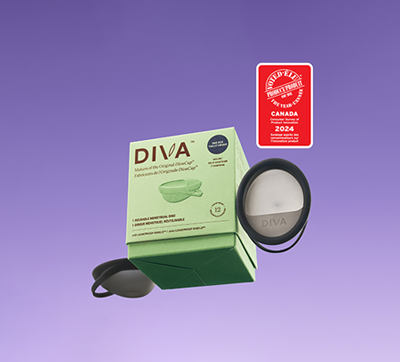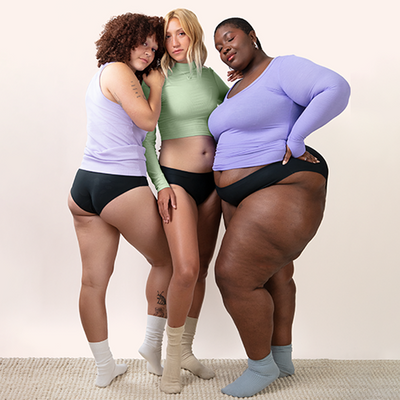
In this article /

In North America alone, close to 20 billion sanitary pads, tampons and applicators are used and disposed of every year.
Additionally, the average menstruating person uses 12,000 – 15,000 pads, tampons and liners in their lifetime, which is equal to 250 – 300 pounds of waste!
The truth is, no disposable period product is recyclable – it all ends up in our landfills and waterways. When you use disposable period products like tampons, pads and liners, you’re contributing to plastic waste. As we all know, plastic can take hundreds of years to break down, and because of this, it will never really go away or fully decompose.
Next month is Plastic Free July, so why not ditch single-use plastic period products and make the switch?
About Plastic Free July

Plastic Free July is a global movement that encourages people to go plastic free for the entire month. The Plastic Free July website provides resources, tips and tricks to help participants stick to their goal and be part of a community that cares about the planet. If you’re ready, you can take the challenge here.
We know that committing to going completely plastic free can be intimidating. Like most lasting change, it helps to start with one small change and go from there.
So, this July, we encourage you to have a plastic free period.
What does it mean to have a “plastic free period”?
To have a plastic free period means refusing to use any period product that contributes to plastic waste. That includes most disposable pads, tampons and liners.
Although there are plastic-free disposables available, such as organic pads and tampons, they can still have a larger negative impact on our environment compared to reusable period products.
The Environmental Impact of Disposable Period Products
It’s estimated that up to 90% of a period pad and 6% of a tampon is plastic, and that one pack of menstrual pads is equivalent to 4-5 plastic bags. The rest of the pad is made of wood pulp and tampons are a mix of cotton, rayon, or both. Plastic tampon applicators are made from polyethylene (PE) and polypropylene (PP). Even tampon strings can be made from PE and PP, two of the most abundant type of microplastics in Mediterranean coastal waters.
That’s because this plastic never goes away. It just breaks down into smaller and smaller pieces, entering the waterways. Marine wildlife confuses these plastic pieces for food, which when ingested cannot be regurgitated. As a result, the wildlife stop eating due to a false sense of fullness and eventually starve to death.
Many people who menstruate choose to flush their tampons – and pads. Plastic free or not, these disposable period products end up in our waterways and clog up our sewage systems. Because of this, disposable menstrual products are the fifth most common type of waste washing up on beaches.
On top of that, the production of disposable products – plastic-free or not – uses more fossil fuel and has a larger contribution to global warming compared to a reusable period product.
For more information, check out our infographic on the environmental impact of period products.
How to Have a Plastic Free Period
If you’re new to the idea of having a plastic free period, don’t worry, we’ve got you.
1. Plastic Free Period Product

There are many great alternatives to single-use tampons, pads and liners. Our favorite is the DivaCup, of course! By switching to the DivaCup, you can save an average of 240 disposable period products each year. With proper care and cleaning your DivaCup can last for several years.
If you’re considering trying a menstrual cup, check out our blog post Is a Menstrual Cup Right For You?
And if you’re ready to get started but are new to the world of menstrual cups, check out our blog post All About Menstrual Cups for Beginners.
Or, if you’re ready to make the switch right now, check out our DivaCup series.
2. Tea

For a lot of people, drinking tea can bring relief and help manage period pain, bloating and cramps.
Raspberry leaf tea is known for lessening cramps and bloating, ginger is great for treating period pain and nausea, and chamomile is great for helping you get enough sleep and calm anxiety.
Unfortunately, a lot of tea bag brands use plastic. You can find select brands that produce plastic free bags, but an even better way to enjoy a nice cup of tea is by choosing loose leaf tea. You can find loose leaf tea at most bulk food stores or specialty tea shops. Simply bring in your own reusable containers to purchase your favorite blends.
Once home, you can use a tea infuser like the one pictured above for a single cup, or a teapot that has its own strainer.
3. Water Bottles

A person will lose about 1-2 ounces of blood during a regular period, so you need to keep drinking water to replace your body’s loss of fluid. It is recommended that you drink roughly 8 glasses of water a day. To help you stay hydrated, be sure to keep a water bottle with you at all times.
To make this habit plastic-free, all you have to do is make it a reusable water bottle.
4. Shopping

What you eat can affect PMS symptoms, and possibly even disrupt your menstrual cycle. As a general rule, it’s important to eat a well-balanced diet to ensure you’re getting the nutrition you need. You can read more about how what you eat affects your menstrual cycle here.
Food plays such an important role in your menstrual health, but how you bring that food home from the store has an impact on our planet. Because the truth is, plastic bags are dangerous to our wildlife and the environment. So, choose to refuse single-use plastic bags at the store and go with a reusable option.
There are reusable options for grocery bags, and produce bags that are made from materials like canvas, muslin, or mesh. Many bulk stores will also allow you to bring your own containers instead of using bags.
5. Period Stains

Period stains happen. Menstrual cups make it less likely, but when first trying something new, there’s a chance of leaking, especially if you don’t have the right fit or are still getting the hang of things (And if this is the case, please contact our Consumer Experience team).
For fresh stains, we recommend rinsing it with cold water and giving it a good scrub with some laundry soap. For a plastic free option, you can use a laundry soap bar like this one.
Let’s Go Plastic Free!
Planet Earth is our shared home and we all have a part to play in protecting it. By choosing to go plastic free during your period, you’re making a big difference.
Will you be part of Plastic Free July by choosing to refuse single-use plastic period products?












